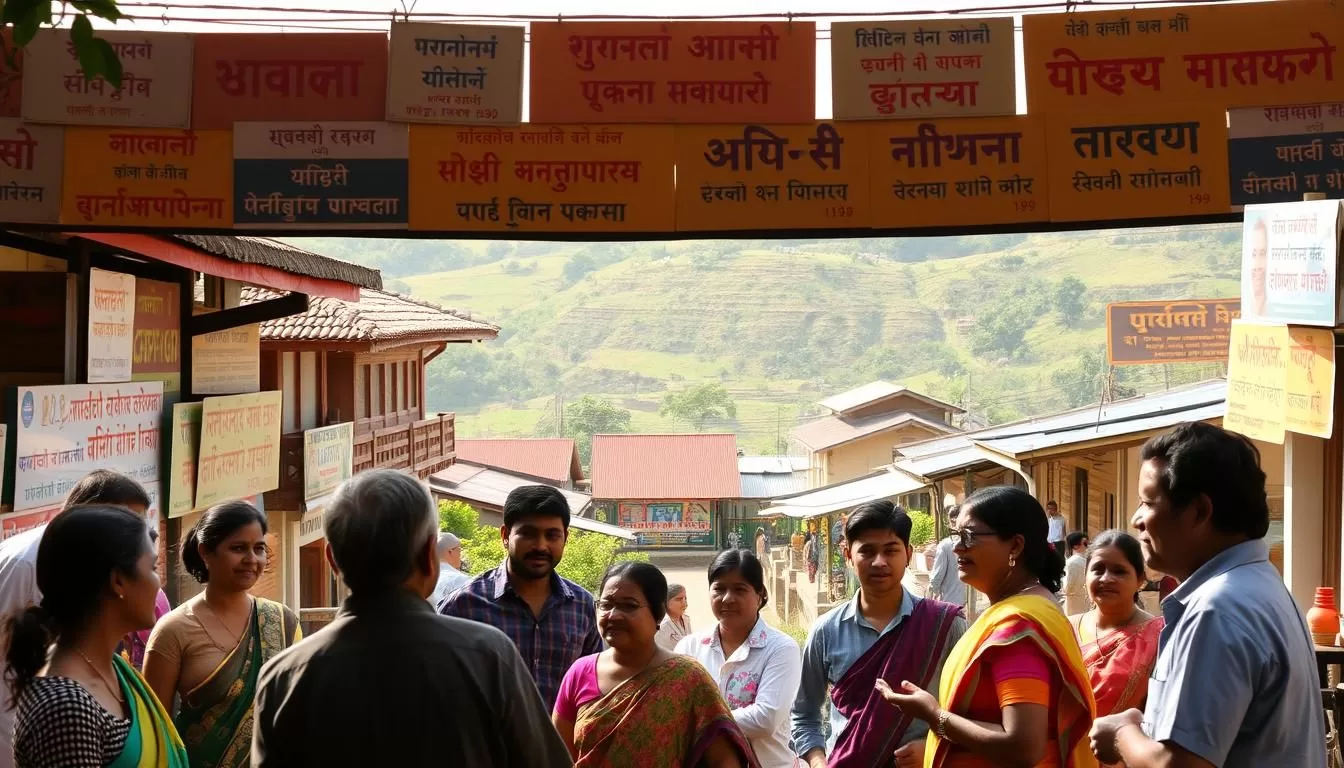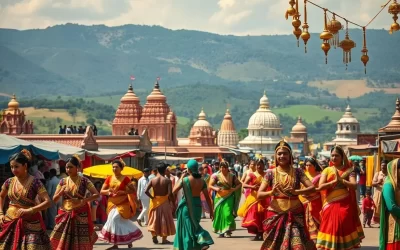✓ Accommodations ✓ Flights ✓ Rental Cars
You are about to explore the fascinating world of languages in Tripura, a state in northeastern India known for its rich cultural heritage.
This region is home to 19 different tribal communities, with a majority population speaking languages that reflect the region‘s diverse history.
As you delve into the linguistic landscape, you’ll discover how languages like Bengali, English, and Kokborok shape the identity and daily life of the people in this state.
The unique blend of cultures and languages in Tripura makes it a captivating subject to explore, offering insights into the historical, geographical, and political factors that have influenced the region.
The Linguistic Landscape of Tripura
As you explore Tripura, you’ll discover a fascinating tapestry of languages that reflects the state’s rich cultural heritage. Tripura, located in northeastern India, is home to a diverse population with a complex history of migration and cultural exchange.
Geographic and Demographic Context
Tripura hosts three different types of ecosystems: mountain, forest, and freshwater. This varied geography has contributed to the development of distinct communities, with roughly half of the state’s population belonging to Scheduled Castes and Scheduled Tribes. The Tribal population is predominantly represented by the Tripuri community, which constitutes more than half of the tribal community.
Other prominent tribal groups include the Reang, the Chakma, the Halam, the Garo, the Lusai, and the Marma. These communities have maintained their unique linguistic traditions despite the influence of more widely spoken languages like Bengali.
Overview of Language Diversity in Tripura
The linguistic diversity in Tripura is remarkable, with languages from multiple language families coexisting within a relatively small geographical area. You can explore the distinct languages spoken by the indigenous community, which comprise nearly half the population.
There are 19 different tribal communities in Tripura, each with their own linguistic traditions. The language diversity reflects Tripura’s complex history of migration, settlement, and cultural exchange between various ethnic groups over centuries. You’ll understand how this linguistic diversity is distributed across Tripura’s varied ecosystems, from mountain communities to those living in forest and freshwater regions.
The state’s language landscape is characterized by the coexistence of multiple languages, including those belonging to the Indo-Aryan and Tibeto-Burman language families. This diversity is a testament to the rich cultural heritage of Tripura and its people.
Historical Evolution of Languages in Tripura
As you explore the historical evolution of languages in Tripura, you’ll discover the significant role of political changes and cultural traditions. The state’s linguistic landscape has been shaped by its complex history, including pre-colonial language traditions, the impact of colonial rule, and post-independence developments.
Pre-Colonial Language Traditions
Before the colonial era, Tripura was home to various indigenous languages, with Kokborok being one of the prominent languages spoken by the Tripuri people. The pre-colonial language traditions in Tripura were characterized by the diversity of languages spoken by different tribes and communities. Kokborok, belonging to the Tibeto-Burman language family, was widely spoken among the indigenous population.
The linguistic diversity of the region was further enriched by the presence of other languages, including those belonging to the Indo-Aryan family. This diversity reflects the cultural richness and complexity of the pre-colonial society in Tripura.
Impact of Colonial Rule on Local Languages
The advent of colonial rule had a profound impact on the linguistic landscape of Tripura. The colonial administration introduced new languages, primarily Bengali and English, which gradually gained prominence in official and educational contexts. The influence of Bengali, in particular, increased significantly during this period, as it became a widely used language in administration and education.
The colonial rule also led to the creation of new linguistic boundaries and challenges, especially with the partition of India in 1947. This event separated Tripura from its traditional plains territories, now in Bangladesh, affecting the linguistic demographics of the region.
Post-Independence Language Development
Following India’s independence in 1947, Tripura underwent significant political changes that impacted its linguistic landscape. The state’s merger with India in 1949 and its subsequent transition from a Part C state to a Union Territory in 1956, and finally to a full-fledged state in 1971, had implications for language administration and policy.
The influx of Bengali Hindu refugees after partition dramatically altered the linguistic demographics, making Bengali speakers the majority. In response, the Tripura government began developing formal language policies, eventually recognizing both Bengali and Kokborok as official languages.
| Year | Event | Impact on Language |
|---|---|---|
| 1947 | India’s independence and partition | Separation from traditional plains territories, new linguistic boundaries |
| 1949 | Tripura Merger Agreement | Tripura became a Part C state of India |
| 1956 | Reorganization of states | Tripura became a Union Territory |
| 1971 | North-Eastern Areas (Reorganisation) Act | Tripura gained full statehood |
Tripura, India: Official and Widely Spoken Languages
Tripura, a state in northeastern India, boasts a rich linguistic diversity with three official languages. The state’s linguistic landscape is shaped by its history, cultural identity, and geographical location. As you delve into the world of Tripura’s languages, you’ll discover the significant roles played by Bengali, Kokborok, and English.
Bengali: The Predominant Language
Bengali is the predominant language in Tripura, widely spoken across the state. It serves as a common medium of communication among people from different backgrounds. The language has a significant presence in daily life, education, and government services. You can see the influence of Bengali in the state’s media, literature, and cultural events.
The widespread use of Bengali in Tripura can be attributed to the state’s historical and cultural ties with neighboring West Bengal. Many people in Tripura use Bengali as their first language, and it’s not uncommon to find Bengali being used in informal settings, such as markets and social gatherings.
Kokborok: The Indigenous Voice
Kokborok is an indigenous language spoken by the Tripuri people, who are the native inhabitants of Tripura. It’s an important part of the state’s cultural heritage and identity. The language is recognized as one of the official languages of Tripura, reflecting the state’s commitment to preserving its indigenous culture.
Efforts have been made to promote Kokborok through education and literature. You can find Kokborok language courses in schools, and there are initiatives to develop Kokborok literature and media. The use of Kokborok in government services and public life is also being encouraged.
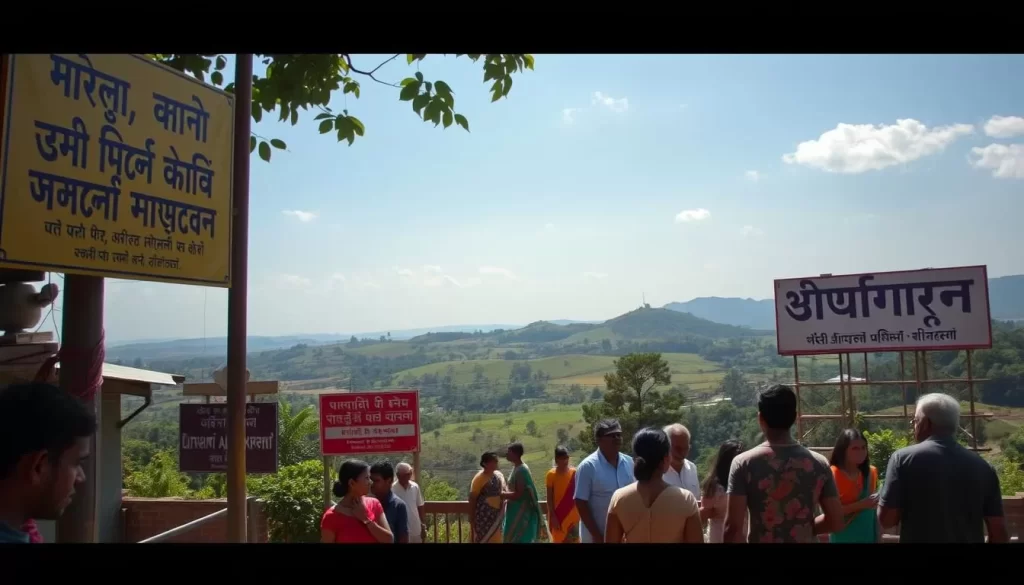
English: Administrative and Educational Role
English plays a crucial role in Tripura’s administrative and educational systems. As one of the state’s official languages, English is used in government offices, courts, and higher education institutions. It’s also the preferred language for official documents that need to be communicated to the central government or international organizations.
In education, English is used as a medium of instruction, particularly in higher education. Many students in Tripura aspire to learn English to improve their career prospects and compete in the global economy. You can see the importance of English in the state’s education system, with many schools and colleges offering English language courses.
| Language | Official Script | Usage |
|---|---|---|
| Bengali | Bengali-Assamese script | Predominant language, widely spoken |
| Kokborok | Bengali-Assamese script, Latin script | Indigenous language, cultural significance |
| English | Latin script | Administrative, educational, and commercial purposes |
Tribal Languages of Tripura
The tribal languages of Tripura, a state with a rich cultural heritage, play a crucial role in the lives of the Scheduled Tribes that constitute a significant portion of the population. Roughly half of the state’s population belongs to Scheduled Castes and Scheduled Tribes, with the Tripuri constituting more than half of the tribal community. This demographic significance underscores the importance of understanding the linguistic diversity within the state.
Reang, Chakma, and Halam Languages
The Reang, Chakma, and Halam communities are among the prominent Scheduled Tribes in Tripura, each with their distinct language. The Reang language is spoken by the Reang community, who are predominantly found in the state’s hilly regions. The Chakma language, belonging to the Indo-Aryan family, is widely spoken among the Chakma people. The Halam language, part of the Tibeto-Burman language family, is another significant tribal language in the region.
These languages are not only means of communication but also carriers of the cultural heritage and traditions of their respective communities. Efforts to preserve these languages are crucial for maintaining the cultural diversity of Tripura.
Garo, Lusai, and Marma Languages
In addition to the Reang, Chakma, and Halam languages, other tribal languages such as Garo, Lusai, and Marma are also spoken in Tripura. The Garo language, spoken by the Garo community, is part of the Tibeto-Burman language family. The Lusai and Marma languages, though lesser-known, are significant to the cultural identity of their respective communities.
These languages contribute to the rich linguistic tapestry of Tripura, highlighting the state’s cultural diversity. Understanding and preserving these languages are essential for the cultural heritage of the state.
Current Status and Speakers
The current status of tribal languages in Tripura varies, with some languages having tens of thousands of speakers, while others have only a few hundred fluent speakers remaining. Factors such as intermarriage, education, migration, and media exposure are affecting the transmission of these languages to younger generations.
| Language | Approximate Number of Speakers | Language Family |
|---|---|---|
| Reang | 20,000 | Tibeto-Burman |
| Chakma | 50,000 | Indo-Aryan |
| Halam | 10,000 | Tibeto-Burman |
| Garo | 5,000 | Tibeto-Burman |
| Lusai | 2,000 | Tibeto-Burman |
| Marma | 3,000 | Tibeto-Burman |
You can gain insight into the demographic status of tribal language speakers in Tripura, where Scheduled Tribes constitute a significant portion of the state’s population. The geographical distribution of tribal language speakers often correlates with Tripura’s hill regions and protected tribal areas, where traditional languages remain stronger.
Language Demographics and Distribution
Understanding the language demographics of Tripura requires examining the interplay between urban and rural language use, as well as the district-wise distribution of languages. You will discover how different factors contribute to the linguistic diversity of the region.
Urban vs. Rural Language Patterns
The linguistic landscape of Tripura varies significantly between urban and rural areas. In urban centers like the capital Agartala, you’ll find a higher concentration of Bengali speakers and a greater linguistic diversity due to urbanization. In contrast, rural areas tend to have a higher prevalence of tribal languages, reflecting the local indigenous communities.
For instance, districts like Dhalai and North Tripura have a larger percentage of their population speaking tribal languages. This variation is largely due to the demographic composition of these areas, where indigenous communities form a significant part of the population.
District-wise Language Distribution
Tripura is divided into eight administrative districts, each with its unique linguistic composition. The distribution of languages across these districts is influenced by historical settlement patterns, geographical features, and administrative boundaries.
The border districts adjacent to Bangladesh show interesting patterns of dialect continuum, with Bengali varieties that share features with those spoken across the border. This phenomenon highlights the complex linguistic dynamics at play in the region.
| District | Predominant Language(s) | Notable Features |
|---|---|---|
| West Tripura | Bengali | Highest linguistic diversity, urbanization |
| Dhalai | Tribal languages | High percentage of indigenous population |
| North Tripura | Tribal languages, Bengali | Significant indigenous and Bengali-speaking populations |
Language Families in Tripura
You will discover that Tripura’s languages are part of various language families, reflecting the region’s rich cultural heritage. The state’s linguistic diversity is a result of its unique geographic location and historical influences.
Indo-Aryan Languages
The Indo-Aryan language family is predominantly represented by Bengali, which is widely spoken in Tripura. Bengali is not only a widely spoken language but also serves as a significant cultural and literary force in the state. As the predominant language, Bengali has influenced other languages spoken in the region, contributing to the linguistic diversity of Tripura.
Tibeto-Burman Languages
Tibeto-Burman languages, such as Kokborok, are integral to the cultural identity of Tripura’s indigenous peoples. Kokborok, also known as Tripuri, is an official language of the state and represents a significant part of the region’s linguistic heritage. Other Tibeto-Burman languages spoken in Tripura include Reang, Halam, and Chakma, each with its unique characteristics and cultural significance. These languages are characterized by their tonal qualities, distinct sentence structures, and vocabularies that differ significantly from Indo-Aryan languages.

The Tibeto-Burman language family connects Tripura to a broader linguistic network that extends across Northeast India, Myanmar, and parts of China and Tibet. Understanding these languages provides insights into the historical and cultural ties between these regions.
Scripts and Writing Systems
Understanding the scripts and writing systems of Tripura is crucial to appreciating its cultural heritage. The state’s linguistic diversity is reflected in the various scripts used for different languages.
Bengali-Assamese Script
The Bengali-Assamese script is predominantly used for Bengali, which is the most widely spoken language in Tripura. This script is also used for other languages such as Assamese. The widespread use of the Bengali-Assamese script is a result of historical and cultural ties between Tripura and neighboring Bengali-speaking regions.
The significance of the Bengali-Assamese script lies in its role in preserving Bengali literature and culture in Tripura. It is used in educational institutions, government offices, and media.
Latin Script Usage
The Latin script has gained popularity in recent years, especially among the younger population and in informal communication. It is often used in digital media and online platforms for languages like Kokborok.
The use of the Latin script for indigenous languages like Kokborok represents a shift towards modernization and global connectivity. However, it also raises questions about cultural preservation and the role of traditional scripts.
The Roman Script Controversy for Kokborok
The choice of script for Kokborok has been a contentious issue, with the Tripura government facing pressure from various tribal organizations to adopt the Roman script. The Twipra Students Federation (TSF) has been at the forefront of this demand, arguing that the Roman script is more phonetically suitable for Kokborok.
The controversy highlights deeper issues related to cultural identity and autonomy. The decision on the script for Kokborok will have significant implications for the language’s preservation and the cultural heritage of the indigenous communities in Tripura.
Language and Education in Tripura
As you explore the educational landscape of Tripura, you’ll discover the intricate relationship between language and learning. The state’s linguistic diversity significantly influences its educational system, presenting both opportunities and challenges.
Medium of Instruction in Schools
The medium of instruction in Tripura’s schools varies, with Bengali being the predominant language used. However, the inclusion of other languages, particularly tribal languages, is crucial for ensuring that students from diverse linguistic backgrounds can access quality education.
You may find that the use of multiple languages as a medium of instruction poses both logistical and pedagogical challenges. For instance, the availability of textbooks and educational materials in languages other than Bengali and English is limited.
Language Curriculum and Policies
The curriculum in Tripura’s schools includes various languages, aiming to promote multilingualism among students. However, the implementation of language policies faces challenges, such as the shortage of qualified teachers proficient in tribal languages.
Some of the key issues include:
- Limited teaching materials and resources for tribal languages
- Insufficient training for educators to teach in multiple languages
- The need for a more inclusive language curriculum that caters to the diverse linguistic backgrounds of students
Challenges in Multilingual Education
Multilingual education in Tripura faces several challenges, including the transition between languages as students progress through the education system. This can create learning gaps, particularly for students from non-Bengali speaking backgrounds.
Furthermore, socioeconomic factors and parental preferences play a significant role in language choices in education. Many tribal families prefer instruction in Bengali or English, perceiving these languages as offering greater economic advantages.
To address these challenges, it’s essential to develop quality educational resources in multiple languages and provide training for educators to effectively teach in a multilingual classroom.
Government Policies and Language Recognition
As you explore the linguistic diversity of Tripura, you’ll find that government policies have been instrumental in promoting local languages. The state government has taken significant steps to address the complex issue of language recognition, balancing the needs of various linguistic communities.
Official Language Acts and Amendments
The Tripura government has enacted various laws and amendments to recognize and promote the state’s official languages. You will discover that the Tripura Official Language Act has played a crucial role in establishing Bengali as the predominant language. Additionally, efforts have been made to include Kokborok and other tribal languages in official contexts.
The government has also introduced amendments to address the evolving linguistic landscape. For instance, the inclusion of Kokborok in the school curriculum and higher education has been a significant step towards promoting indigenous languages. However, the decision to adopt the Roman script for Kokborok remains a contentious issue, influenced by political and administrative considerations.
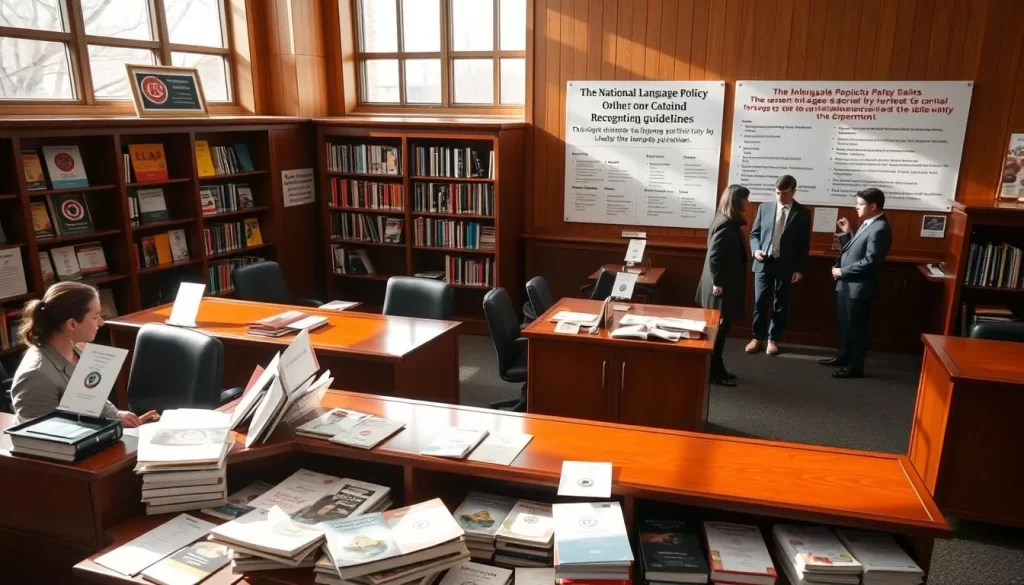
Implementation and Challenges
Despite official recognition, the implementation of language policies faces several challenges. You will learn that bureaucratic hurdles, resource constraints, and political considerations have affected the full implementation of these policies. For example, while Kokborok is recognized as an official language, Bengali continues to dominate government operations.
The practical challenges involved in implementing multilingual policies across various government departments and public services are significant. You will understand how changing government priorities and administrative realities have influenced the implementation of language policies over time, sometimes creating gaps between official recognition and practical support.
- The ongoing debate about script choice for Kokborok exemplifies how technical linguistic issues can become politically charged and difficult to resolve.
- The state government faces the challenge of balancing the promotion of local languages with the need for a unified administrative language.
Cultural Significance of Languages in Tripura
In Tripura, language is not just a means of communication, but a cornerstone of cultural heritage. The state’s linguistic diversity is reflected in its vibrant cultural landscape, where mainstream Indian cultural elements coexist with traditional practices of ethnic groups.
Language and Cultural Identity
The languages spoken in Tripura play a crucial role in shaping the cultural identity of its people. The use of locally crafted musical instruments, traditional clothes, and the worship of regional deities are all integral to the cultural practices of the state. For instance, the sculptures at archaeological sites like Unakoti, Pilak, and Devtamura provide historical evidence of artistic fusion between organized and indigenous religions.
You’ll find that the cultural identity of Tripura is deeply intertwined with its linguistic heritage. The various dances performed during religious occasions, weddings, and festivities are not just forms of entertainment but also a means of preserving cultural traditions.
Festivals, Literature, and Arts
Tripura’s languages find expression through various cultural forms, including festivals, literature, music, dance, and theatrical traditions. The state celebrates numerous cultural festivals like Garia Puja, Kharchi Puja, and Ker Puja, where language plays a crucial role in rituals, songs, and performances. Traditional folk performances such as Lebang dance, Mamita dance, and Hozagiri dance often incorporate songs and oral narratives in tribal languages, thus preserving linguistic heritage.
| Festival | Language Significance | Cultural Practice |
|---|---|---|
| Garia Puja | Rituals and songs in tribal languages | Traditional dances and worship |
| Kharchi Puja | Use of Kokborok and Bengali languages | Worship of regional deities |
| Ker Puja | Oral narratives in tribal languages | Folk performances and festivities |
The literary traditions in Tripura span multiple languages, with Bengali literature having the longest documented history. Emerging written traditions in Kokborok and other tribal languages are also gaining prominence. Contemporary artists and cultural practitioners are creating new forms of expression that blend traditional linguistic elements with modern themes and media, ensuring the cultural heritage continues to thrive.
Language Preservation Efforts
The people of Tripura are working together to preserve their languages, with efforts spanning government-backed schemes and community-led preservation projects. You will discover how these collaborative endeavors are crucial in maintaining the region’s linguistic diversity.
Government Initiatives
The government has launched several initiatives aimed at preserving the languages of Tripura. These include the development of language curricula for schools and the publication of educational materials in local languages. Government support is vital for the success of these projects, as it provides the necessary resources for language documentation and education.
For instance, the government has established language committees that work closely with local communities to develop language learning materials. You can see the impact of these efforts in the improved language education programs across the state.
| Initiative | Description | Impact |
|---|---|---|
| Language Curriculum Development | Creation of curricula for local languages | Enhanced language education in schools |
| Publication of Educational Materials | Production of textbooks and learning aids in local languages | Increased access to educational resources for local language speakers |
| Language Committees | Collaboration between government and local communities | Improved relevance and effectiveness of language preservation efforts |
Community-Led Preservation Projects
Community-led projects are also playing a significant role in language preservation. Local community groups are organizing cultural events, language festivals, and competitions to promote the use of local languages among younger generations. You will learn about the various ways these community initiatives are helping to keep the languages of Tripura alive.
For example, community-created websites and mobile applications are being developed to teach and promote tribal languages. These digital resources are invaluable for language learners and help to ensure the continued use of these languages in modern contexts.
As you explore the language preservation efforts in Tripura, you will understand the importance of collaboration between government initiatives and community-led projects. Together, they are making a significant impact on the preservation of the region’s linguistic heritage.
Comparison with Other Northeastern States
As you explore the linguistic landscape of northeastern India, you’ll notice that Tripura stands out among its peers. The state’s language dynamics are shaped by its unique history, geography, and demographic changes. When comparing Tripura to other northeastern states, several interesting similarities and differences emerge.
Linguistic Similarities with Neighboring States
Tripura shares some linguistic similarities with its neighboring states in the northeastern region. For instance, like Assam, Tripura has a significant presence of Indo-Aryan languages, with Bengali being a predominant language in Tripura. Similarly, the Tibeto-Burman language family is represented in both Tripura and Assam, with languages like Kokborok in Tripura and Bodo in Assam. Arunachal Pradesh, on the other hand, is characterized by a diverse array of Tibeto-Burman languages, some of which are also found in Tripura, albeit with different dialects and speaker populations.
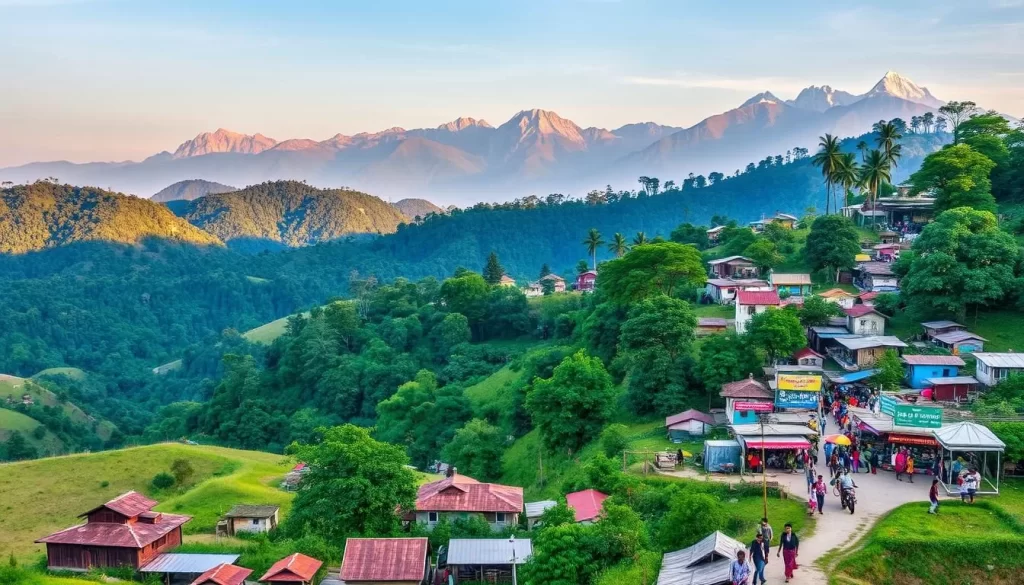
Unique Features of Tripura’s Language Scenario
Despite these similarities, Tripura’s language scenario has several unique features. Unlike Arunachal Pradesh, where English is used for official purposes due to the absence of a designated official language, Tripura has officially recognized Bengali and Kokborok. This bilingual approach to official languages sets Tripura apart from states like Assam, where Assamese dominates. Additionally, Tripura’s proximity to Bangladesh creates a unique cross-border linguistic dynamic, influencing the prevalence of Bengali in the state. The historical experience of being a princely state has also shaped Tripura’s language policies in ways that differ from other northeastern states with different political histories.
Understanding these nuances is crucial for appreciating the complex linguistic tapestry of northeastern India, where each state has its own distinct story to tell.
Media and Communication in Tripura’s Languages
You will find that the media in Tripura accommodates various languages, reflecting the state’s cultural richness. The use of multiple languages in media is a testament to the state’s linguistic diversity. This diversity is reflected across various media platforms, including print, digital, radio, television, and film.
Print and Digital Media
The print and digital media in Tripura cater to a diverse audience by publishing content in multiple languages. Bengali and Kokborok are among the prominent languages used in newspapers and online publications. The digital media landscape is evolving, with online news portals and social media platforms increasingly using local languages to reach a wider audience in the state.
Radio, Television, and Film
Broadcast media in Tripura accommodates the state‘s multilingual reality through programming in various languages. All India Radio’s Agartala station broadcasts programs in Bengali, Kokborok, and other tribal languages, providing an important platform for linguistic expression. Doordarshan Tripura, the state television channel, also includes programming in multiple languages, although Bengali content is predominant.
The film industry in Tripura has historically been dominated by Bengali productions, but there has been a recent emergence of Kokborok-language films that address tribal themes and perspectives. Digital platforms and streaming services are creating new opportunities for content in Tripura’s languages, potentially reaching audiences beyond traditional broadcast boundaries, thus catering to the diverse population in the state every year.
Some key aspects of media and communication in Tripura include:
- The role of All India Radio and Doordarshan in promoting local languages.
- The emergence of Kokborok-language films and their significance.
- The growing importance of digital media in reaching a wider audience.
Impact of Migration on Language Dynamics
Tripura’s linguistic profile has been influenced by various migration waves, leading to a complex language scenario. The state’s demographic makeup has been significantly altered by historical and contemporary migration patterns.
Historical Migration Patterns
The influx of refugees from erstwhile East Pakistan and present-day Bangladesh has led to the minoritisation of the indigenous peoples of Tripura. This historical migration pattern has had a lasting impact on the language dynamics, with the Bengali language becoming predominant. As a result, the indigenous languages, such as Kokborok, have faced challenges in maintaining their speaker base among the changing population.
You can observe how the demographic shift has influenced the language use in various aspects of life, from education to daily communication. The historical context sets the stage for understanding the contemporary language shifts in Tripura.
Contemporary Language Shifts
Internal migration within the state, particularly from rural to urban areas, accelerates language shift as tribal language speakers adapt to Bengali-dominated urban environments. You will notice that younger generations of tribal communities increasingly use Bengali or English in education and professional contexts, leading to language attrition. Despite being a numerical minority, indigenous communities are asserting their linguistic rights more strongly, leading to revitalization efforts for Kokborok and other tribal languages.
Economic factors, educational opportunities, and social mobility considerations significantly influence individual and community language choices in present-day Tripura. As you explore the language dynamics further, it becomes evident that the population’s language preferences are shifting, with a growing emphasis on languages that offer better socio-economic prospects.
The language dynamics in Tripura reflect a complex interplay between historical migration patterns, contemporary demographic changes, and the aspirations of its diverse population. Understanding these dynamics is crucial for appreciating the linguistic diversity and the challenges faced by the indigenous languages in the region.
Learning Resources for Tripura’s Languages

Learning the languages of Tripura is now more accessible than ever, thanks to a growing array of educational resources. You can explore various materials and tools designed to help you understand and appreciate the linguistic diversity of the region.
Books and Educational Materials
For those interested in traditional learning methods, there are numerous books and educational materials available for languages such as Bengali and Kokborok. Textbooks, dictionaries, and grammar guides are essential resources for learners. You can find these materials in local bookstores or through online retailers.
Online Resources and Applications
The digital age has brought a plethora of online resources and applications to learn Tripura’s languages. Online dictionaries, translation tools, and language learning websites are making Bengali more accessible to non-native speakers. You can also find mobile applications developed specifically for Kokborok and other tribal languages, offering interactive learning experiences.
Furthermore, social media groups, YouTube channels, and online forums dedicated to Tripura’s languages provide informal learning spaces and community support for language learners. Digital documentation projects are also creating valuable archives of endangered languages, preserving them for future generations.
Conclusion: The Future of Linguistic Diversity in Tripura
As Tripura navigates the complexities of globalization and economic development, the future of its linguistic diversity hangs in the balance. The state’s rich linguistic heritage, comprising languages like Bengali, Kokborok, and various tribal languages, is facing both challenges and opportunities. The continued vitality of Tripura’s languages will depend on balanced policies that support both major languages and indigenous languages.
The exploration ofnatural gasresources and subsequent economic development may bring about significant changes to the linguistic landscape. Industrial growth often leads to migration, which can influence language dynamics. However, the growing recognition of indigenous rights globally may strengthen efforts to preserve tribal languages, potentially reversing some trends toward language loss.
In the capital city ofAgartala, a multilingual hub, Bengali will likely continue to dominate, while other languages maintain their presence in specific domains. Tripura’s experience offers valuable lessons for other linguistically diverse regions facing similar challenges.
Preserving linguistic diversity is not just about cultural heritage; it’s also about maintaining the knowledge systems and worldviews embedded in each language. The ultimate future of Tripura’s linguistic diversity rests with its people and their commitment to valuing and transmitting their languages to future generations.
Withnatural gasreserves being a significant resource, the state’s development trajectory will be crucial in shaping its linguistic future. TheTripura governmentand community initiatives will play a vital role in promoting linguistic diversity.
By embracing its linguistic diversity and promoting the use of indigenous languages like Kokborok and other tribal languages, Tripura can set an example for other regions inNortheast India. The future of Tripura’s languages is intricately linked with the choices made by its people, policymakers, and the broader socio-economic context.
The above is subject to change.
Check back often to TRAVEL.COM for the latest travel tips and deals.
